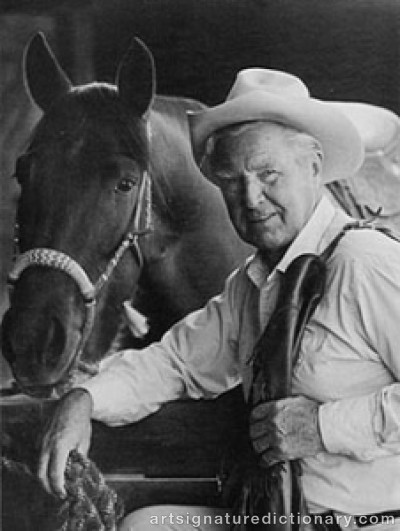
Olaf Carl WIEGHORST
1899–1988, Denmark/USA
Also known as: OW
Biography
Discover the life and artistic journey of Olaf Carl WIEGHORST (born 1899, Denmark, died 1988, USA), including key biographical details that provide essential context for signature authentication and artwork verification. Understanding an artist's background, artistic periods, and career timeline is crucial for distinguishing authentic signatures from forgeries.
Olaf Wieghorst biography:
Olaf Wieghorst (1899-1988) was born in Viborg, Denmark and is known for his Western genre, Indian, cowboy and horse paintings. By the age of nine he was skilled in horseback acrobatics and performed as a stunt rider for the Danish Circus (Tivoli Theater in Copenhagen) and also throughout different parts of Europe. Olaf Wieghorst also worked on a farm where he regularly rode horses. He developed a love for horses and they were to become a major theme in his paintings during his career as an artist.
Working as a cabin boy on a steamship, Olaf Wieghorst arrived in the United States in 1918.
As a young man he served in the military as part of the U.S. Cavalry. During this time with the cavalry, Olaf Wieghorst worked on the Mexican border during the days of the Mexican revolutionary general, Pancho Villa. In 1921 Olaf Wieghorst suffered a broken ankle in El Paso, Texas when a favorite horse he was riding fell on him. His troop was on the way to Arizona at the time of his injury and he did not want to be left behind. Olaf Wieghorst opted to stay on his horse and continue on with his troop through the New Mexico desert during the hottest time of the year. That night, his horse died as a result of pushing forward to save Olaf Wieghorsts’ life.
After leaving the cavalry, Olaf Wieghorst (also known as O. Wieghorst) travelled a great deal throughout the West where he often found work as a cowboy in New Mexico and Arizona. Olaf Wieghorst later worked as a mounted policeman in New York until as late as 1944. Most of his time as a mounted policeman was spent on a horse by the name of Rhombo. His patrols put him on the Central Park bridle paths where Olaf Wieghorst saved numbers of people from being injured by runaway horses.
Olaf Wieghorst was a self-taught artist and took up painting in his time off.
He became so proficient with painting that Grand Central Art Galleries of the Biltmore Hotel chose to represent him as an artist. During his career, Olaf Wieghorst would learn to master oil painting and watercolor painting, as well as numerous other art mediums.
“From the opening of the American West until this present day, artists have sought to capture the rugged beauty, the drama and the romance of this unique part of our national heritage. None have been more successful then Olaf Wieghorst.”
–Ronald Reagan
In 1924, Olaf Wieghorst married a Brooklyn girl named Mabel Walters. The couple and their son moved to the city of El Cajon, California in San Diego County in 1944. They were to live there for more than forty years. See photos of his ranch house here. Olaf Wieghorst built a studio that he outfitted extensively with western memorabilia and he also maintained two horses that he kept for use as models and for riding. It was about this time that Olaf Wieghorst devoted all of his energies to painting. His love of horses and the west showed in his paintings and the common them of his better art work is comprised of Western genre, horses, cowboys and Indians. In fact his best works were done while he was in California when the primary subject matter of his paintings was horses and cowboys. Olaf Wieghorst also created a number of horse portraits and would study their personalities as part of creating the painting. Some of the more famous horses captured in the paintings of Olaf Wieghorst were Gene Autry’s Champion, Tom Morgan’s stallion and Roy Rogers’ Trigger.
Olaf Wieghorst died of respiratory complications at the age of 88. What an amazing life he lived!
Explore other artists
Discover other notable artists who were contemporaries of Olaf Carl WIEGHORST. These artists worked during the same period, offering valuable insights into artistic movements, signature styles, and authentication practices. Exploring related artists makes it easier to recognize common characteristics and artistic conventions of their era.